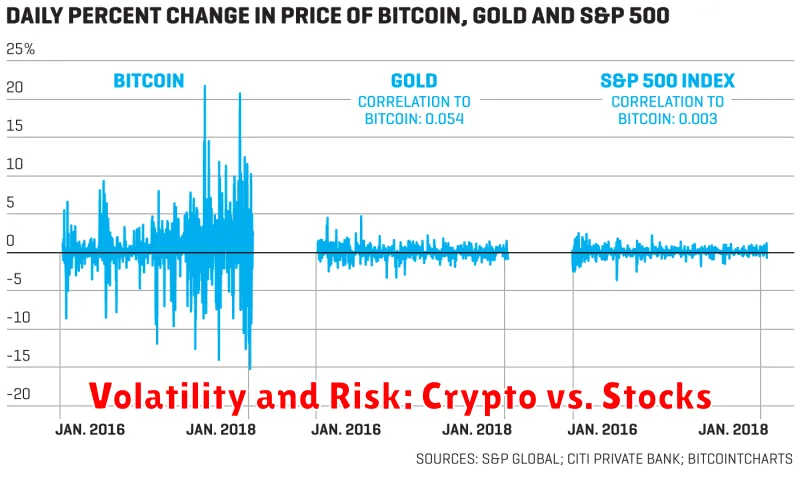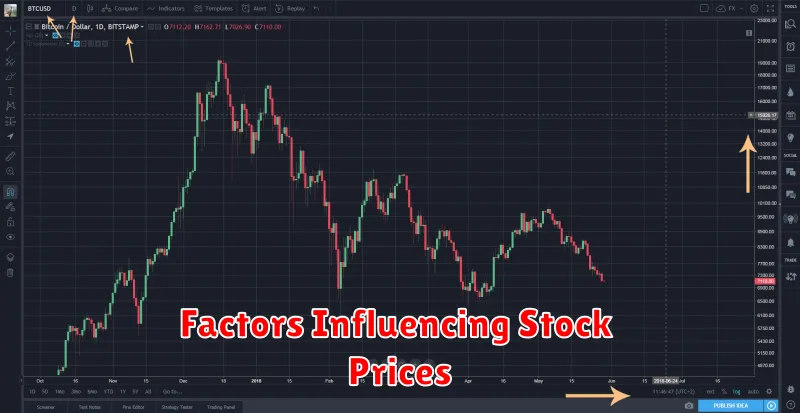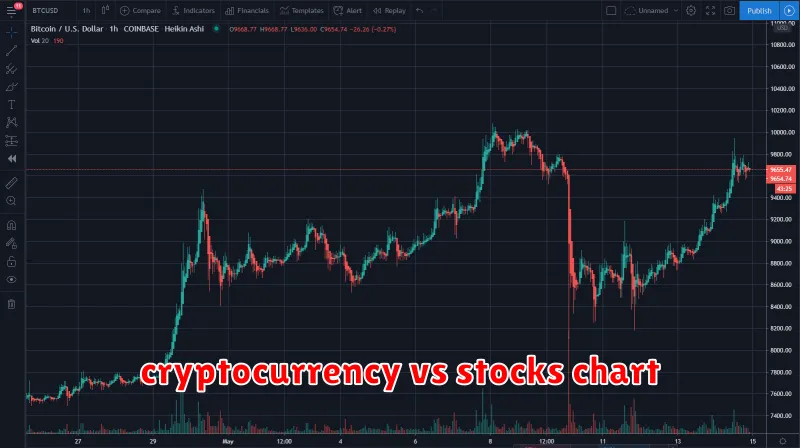Deciding where to invest your hard-earned money can be a daunting task, especially with the rise of new and exciting markets like the cryptocurrency world. While traditional stock markets have long been a popular choice for investors, the allure of cryptocurrencies like Bitcoin and Ethereum has captured the attention of many. Both offer potential for growth and profit, but understanding the key differences and risks associated with each is crucial before making any investment decisions. This article will delve into the world of cryptocurrency vs. stock market, exploring their unique characteristics, potential rewards, and inherent dangers.
Navigating the complexities of these two markets requires a solid grasp of their fundamental differences. The stock market, rooted in centuries of history, represents ownership in publicly traded companies. In contrast, the cryptocurrency market is a relatively new phenomenon, built on decentralized blockchain technology. This fundamental difference leads to a range of other key distinctions, from regulatory frameworks and trading mechanisms to the underlying assets and potential returns. By gaining a comprehensive understanding of both realms, you can make informed decisions that align with your financial goals and risk tolerance.
What are Cryptocurrencies?

Cryptocurrencies are digital or virtual currencies that use cryptography for security. They are decentralized, meaning they are not subject to government or financial institution control. Instead of relying on central banks or governments, they operate on a decentralized network of computers, often using blockchain technology.
The most well-known cryptocurrency is Bitcoin, but there are thousands of others, each with its own unique features and purposes. Some cryptocurrencies are designed for payments, others for smart contracts, and still others for decentralized finance (DeFi) applications.
Key characteristics of cryptocurrencies include:
- Decentralization: No single entity controls the network.
- Transparency: All transactions are recorded on a public ledger, making them verifiable.
- Security: Cryptography ensures the security of transactions and the integrity of the network.
- Limited supply: Many cryptocurrencies have a finite supply, which can influence their value.
How Does the Stock Market Work?
The stock market is a complex system that allows investors to buy and sell shares of publicly traded companies. These shares, also known as stocks, represent ownership in a company. When you buy a stock, you’re essentially becoming a part-owner of that company.
The stock market operates through a network of stock exchanges, which are marketplaces where buyers and sellers meet to trade stocks. Some of the most well-known exchanges include the New York Stock Exchange (NYSE) and the Nasdaq.
The price of a stock is determined by supply and demand. When more people want to buy a particular stock, its price goes up. Conversely, if more people are selling, the price goes down. This constant fluctuation in prices is what makes the stock market so dynamic.
Investors can buy and sell stocks through brokerage accounts. These accounts allow investors to access the stock market and execute trades. Brokers can either be individuals or firms that act as intermediaries between investors and exchanges.
Volatility and Risk: Crypto vs. Stocks

Both cryptocurrencies and stocks are considered risky investments, but they exhibit different levels of volatility and risk profiles. Understanding these distinctions is crucial for making informed investment decisions.
Cryptocurrencies are known for their extreme volatility, with prices often fluctuating dramatically within short periods. This high volatility is driven by factors such as market speculation, regulatory uncertainty, and technological advancements. The nascent nature of the cryptocurrency market, coupled with its lack of traditional financial infrastructure, contributes to its inherent riskiness.
Stocks, on the other hand, typically exhibit lower volatility than cryptocurrencies. While stock prices can fluctuate significantly, they are generally backed by tangible assets, earnings, and established businesses. The stock market is also more regulated and transparent, offering investors a higher level of confidence and protection.
Risk in the context of investing refers to the potential for loss. Both cryptocurrencies and stocks carry inherent risks, but the nature of those risks differs. Cryptocurrencies are more susceptible to fraud, hacking, and regulatory crackdowns. Stocks, while more established, can be affected by macroeconomic factors, industry competition, and company-specific risks.
In summary, cryptocurrencies are highly volatile and risky, offering the potential for substantial gains but also significant losses. Stocks, while less volatile, still carry inherent risks, but their established nature and regulatory framework provide a greater sense of security. The choice between cryptocurrencies and stocks ultimately depends on an investor’s risk tolerance, investment goals, and understanding of the market dynamics.
Regulation and Security
One of the most significant differences between cryptocurrencies and the stock market lies in their regulatory landscapes. The stock market is heavily regulated by government agencies like the Securities and Exchange Commission (SEC) in the US. These regulations ensure transparency, investor protection, and market integrity. However, the cryptocurrency market, in its nascent stages, has seen varying levels of regulation globally.
This lack of comprehensive regulatory frameworks presents both challenges and opportunities. On the one hand, it can foster innovation and rapid development. On the other hand, it can lead to market manipulation, fraud, and lack of consumer protection. The volatile nature of cryptocurrencies also makes them susceptible to hacks and security breaches, emphasizing the need for robust security measures.
In contrast, the stock market enjoys robust security measures, including stringent exchange protocols and regulatory oversight. While not immune to fraud, the established framework provides a level of security that is currently lacking in the cryptocurrency world. As the cryptocurrency market matures, regulations are likely to evolve, aiming to strike a balance between fostering innovation and protecting investors.
Market Capitalization and Liquidity
One of the most crucial differences between the cryptocurrency market and the stock market lies in the concepts of market capitalization and liquidity. Understanding these factors is vital for any investor, as they influence the price stability and trading potential of assets.
Market capitalization refers to the total market value of a company or cryptocurrency. It is calculated by multiplying the current price of a single unit (stock or coin) by the total number of units in circulation. In the stock market, companies with higher market caps are often considered more established and stable. However, in the cryptocurrency market, market capitalization is a less reliable indicator of stability due to the volatile nature of the market.
Liquidity refers to the ease with which an asset can be bought or sold without significantly affecting its price. A highly liquid asset can be traded quickly and easily, while a less liquid asset may experience price fluctuations due to limited buyers or sellers. The stock market generally exhibits higher liquidity compared to the cryptocurrency market, especially for large-cap companies. While certain cryptocurrencies like Bitcoin have achieved significant liquidity, many altcoins still suffer from low trading volume and limited market depth, leading to higher price volatility.
The disparity in market capitalization and liquidity between the two markets has significant implications for investment strategies. Investors should carefully consider the risks associated with both markets and choose investments based on their individual risk tolerance and financial goals.
Investment Strategies: Long-Term vs. Short-Term
When it comes to investing, the time horizon plays a crucial role in determining the appropriate strategy. Long-term investing, typically spanning several years or even decades, focuses on building wealth over time through steady growth and compounding returns. This approach prioritizes patience, discipline, and a diversified portfolio. On the other hand, short-term investing, often measured in weeks, months, or a few years, aims to generate quick profits by capitalizing on market fluctuations. This strategy involves more frequent trading, higher risk tolerance, and a focus on market analysis and technical indicators.
Long-term investors generally favor a buy-and-hold strategy, where they invest in assets with a proven track record and hold them for extended periods, allowing them to ride out market volatility and capitalize on long-term growth trends. This approach is suitable for investors with a lower risk tolerance and a focus on capital preservation. Short-term investors, however, adopt a more active trading style, frequently buying and selling assets based on market conditions and technical signals. This strategy is often employed by traders seeking higher returns but accepting a greater risk of losses. It’s important to recognize that short-term investing requires a deeper understanding of market dynamics and technical analysis.
The choice between long-term and short-term investing depends on individual circumstances, risk appetite, and financial goals. Long-term investing aligns well with individuals seeking long-term wealth accumulation and financial security, while short-term investing might suit those seeking to maximize returns over shorter periods. Ultimately, the ideal strategy is one that aligns with your investment objectives, risk tolerance, and financial situation.
Factors Influencing Cryptocurrency Prices

The cryptocurrency market is known for its volatility, with prices fluctuating wildly even within a single day. Understanding the factors that influence these price movements is crucial for anyone considering investing in cryptocurrencies. While several factors contribute to price changes, some of the most significant ones are discussed below:
1. Supply and Demand: Like any other asset, the price of cryptocurrencies is determined by the interplay of supply and demand. When demand exceeds supply, prices tend to rise, and vice versa. Factors influencing demand include investor sentiment, media coverage, and adoption by businesses and individuals.
2. Mining and Hash Rate: The process of mining new cryptocurrencies involves solving complex mathematical problems. The difficulty of these problems and the computational power dedicated to solving them (hash rate) influence the supply of new coins. A higher hash rate typically results in a more secure network and can lead to higher prices, while a lower hash rate may signal a decrease in network security and potentially lower prices.
3. Regulations and Government Policies: Governments around the world are still grappling with how to regulate cryptocurrencies. Positive regulations and clear legal frameworks can boost investor confidence and drive prices upward. Conversely, negative news or unclear regulations can lead to price declines.
4. Technological Advancements: Innovations in blockchain technology and the development of new cryptocurrency projects can significantly impact the market. Positive developments can generate excitement and drive prices higher, while negative news or security vulnerabilities can trigger sell-offs.
5. Market Sentiment and Speculation: Cryptocurrency markets are often driven by speculation and herd behavior. Positive news, announcements, or market trends can lead to rapid price increases, while negative news or a change in sentiment can trigger sell-offs.
6. Macroeconomic Factors: Global economic events, such as interest rate changes, inflation, and geopolitical instability, can also influence cryptocurrency prices. For example, during periods of economic uncertainty, investors may seek refuge in safe-haven assets like gold, potentially leading to a decline in cryptocurrency prices.
It’s essential to remember that the cryptocurrency market is still relatively young and volatile. Understanding these factors can help you make informed decisions and manage your investment risks.
Factors Influencing Stock Prices

The stock market is a complex and dynamic ecosystem where the prices of publicly traded companies fluctuate constantly. Numerous factors influence these price movements, creating both opportunities and risks for investors. Understanding these factors is crucial for making informed investment decisions.
Company Performance is a fundamental driver of stock prices. Strong earnings, revenue growth, and market share gains typically lead to higher valuations. Conversely, declining profits, revenue stagnation, or poor management decisions can result in stock price declines. Investors analyze financial statements, earnings calls, and industry reports to assess a company’s performance and potential.
Economic Conditions play a significant role in stock prices. Strong economic growth, low unemployment, and rising consumer confidence generally boost stock values. Conversely, recessions, high inflation, and economic uncertainty can lead to market downturns. Investors monitor macroeconomic indicators such as GDP growth, interest rates, and inflation to gauge the overall health of the economy.
Industry Trends can impact stock prices as specific sectors experience growth or decline. Technological advancements, regulatory changes, and consumer preferences can influence the performance of certain industries. For example, the rise of e-commerce has significantly benefited online retailers, while traditional brick-and-mortar stores have faced challenges.
Investor Sentiment and market psychology are important factors. When investors are optimistic about the future, they tend to buy stocks, pushing prices higher. Conversely, pessimism can lead to selling pressure and lower prices. Market sentiment can be influenced by news events, economic data, and investor speculation.
Supply and Demand also play a role in stock prices. When demand for a particular stock is high, the price tends to rise. Conversely, if supply exceeds demand, the price may decline. Factors such as new stock offerings, share buybacks, and institutional trading can impact supply and demand.
Government Policies can affect stock prices through changes in regulations, taxes, and monetary policy. For example, interest rate hikes can make it more expensive for companies to borrow money, potentially slowing economic growth and impacting stock valuations.
It’s important to remember that stock prices are constantly in motion, and no single factor can fully explain their movements. Understanding these key influences helps investors navigate the complexities of the stock market and make more informed investment decisions.
Diversification and Portfolio Allocation
When it comes to investing, diversification is key. This means spreading your investments across different asset classes to reduce risk. This can be done by investing in both cryptocurrencies and the stock market. However, it is important to understand the key differences and risks associated with each asset class.
Cryptocurrencies are considered a highly volatile and risky asset class. Their value can fluctuate significantly in a short period of time. However, they also have the potential for high returns. Stocks are generally considered to be a less volatile asset class than cryptocurrencies. However, they still carry some risk, and their value can be affected by factors such as economic conditions and company performance.
When it comes to portfolio allocation, it is important to consider your risk tolerance and investment goals. If you are comfortable with a high level of risk, you may choose to allocate a larger portion of your portfolio to cryptocurrencies. However, if you are risk-averse, you may prefer to allocate a larger portion of your portfolio to stocks.
It is also important to consider the correlation between different asset classes. Cryptocurrencies and stocks are generally considered to be negatively correlated, which means that when one asset class is performing well, the other is likely to be performing poorly. This can be a good way to diversify your portfolio and reduce your overall risk.
Ultimately, the best way to determine how to allocate your portfolio is to consult with a financial advisor who can help you create a plan that is tailored to your individual needs and goals.
Understanding Your Risk Tolerance
Before diving into the exciting world of cryptocurrency and the stock market, it’s crucial to understand your risk tolerance. This refers to your personal comfort level with the potential for losses in your investments. It’s like a personal gauge of how much volatility you can stomach.
High-risk tolerance means you’re comfortable with the possibility of significant losses, but also excited about the potential for high returns. Low-risk tolerance means you prefer investments with more predictable outcomes, even if it means lower potential gains.
Your risk tolerance is influenced by factors like your age, financial situation, investment goals, and personal personality. A young investor with a long time horizon might be more comfortable with higher risk than a retiree with a shorter time horizon and a need for stable income.
Honestly assessing your risk tolerance is crucial to making informed investment decisions. It helps you choose investments that align with your goals and comfort level, rather than being swayed by market trends or the allure of potentially quick gains.
The Future of Cryptocurrency and the Stock Market
The future of cryptocurrency and the stock market is a subject of much debate and speculation. Both have experienced significant growth in recent years, but their paths are likely to diverge in the future.
Cryptocurrency is still a relatively new asset class with a high level of volatility. Its value is highly dependent on market sentiment and speculation. While it has the potential to revolutionize finance, its future remains uncertain. Many factors will influence its growth and adoption, including regulatory developments, technological advancements, and investor confidence.
The stock market, on the other hand, is a more established and regulated asset class. It has a long history of growth and provides investors with a diverse range of investment opportunities. While the stock market can be volatile, it is generally considered a more stable and predictable investment than cryptocurrency.
The future of both cryptocurrency and the stock market will be shaped by factors such as economic growth, interest rates, and global events. It is likely that both will continue to evolve and adapt to the changing landscape of the financial world.
Potential for Growth and Adoption

The potential for growth and adoption of both cryptocurrencies and the stock market is vast, but their paths differ significantly. The stock market is a more established and regulated market with a long history of success and predictable growth. Its potential for growth is tied to the overall economic health of the countries and businesses involved.
Cryptocurrencies, on the other hand, are relatively new and volatile. Their potential for growth depends heavily on factors like regulatory clarity, technological advancements, and user adoption. The decentralized and borderless nature of cryptocurrencies could potentially disrupt traditional financial systems and offer greater financial inclusion.
Adoption is a crucial factor for both markets. While the stock market enjoys widespread adoption, cryptocurrencies still face significant challenges in mainstream acceptance. Adoption requires overcoming barriers like lack of understanding, regulatory uncertainty, and volatility.
Ultimately, the growth and adoption of both cryptocurrencies and the stock market will depend on various factors, including technology, regulation, and investor confidence. Both have their own unique risks and rewards, and understanding these differences is crucial for any investor.
Impact of Government Regulations

Government regulations play a significant role in shaping the landscape of both the cryptocurrency market and the stock market. While both markets are subject to regulatory oversight, the approach and extent of regulation differ considerably.
In the stock market, regulations are well-established and comprehensive. They aim to protect investors, ensure market integrity, and prevent fraud. Regulatory bodies like the Securities and Exchange Commission (SEC) in the US set strict rules for listing companies, trading practices, and investor disclosures.
The cryptocurrency market, on the other hand, is still in its early stages of development and is evolving rapidly. This has led to a more fragmented and complex regulatory landscape. Governments around the world are grappling with how to regulate cryptocurrencies, considering their decentralized nature and potential for illicit activities. Some jurisdictions have adopted a more hands-off approach, while others are actively pursuing stricter regulations.
The impact of government regulations on both markets can be significant.
For the stock market, clear and well-defined regulations have helped foster investor confidence and stability. However, excessive regulation can sometimes stifle innovation and hinder market growth.
For the cryptocurrency market, regulation can help bring legitimacy and transparency, attracting institutional investors and mainstream adoption. But overly restrictive regulations can stifle innovation and drive activities underground.
It is essential for investors to understand the regulatory landscape of both the cryptocurrency and stock markets before making any investment decisions. The impact of regulation on the future development of both markets is likely to be significant and continues to evolve.
